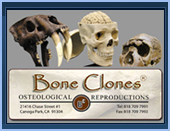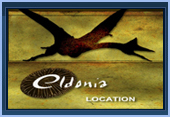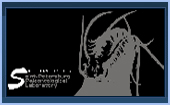화석명 : Pterosauria (익룡)
학 명 : Pteranodon sternbergi (테라노돈 / 프테라노돈)
시 대 : Cretaceous(백악기)
크 기 : Size: wingspan 3.35 meters (11 feet) Skull 87 cm (34 inches) long
전시방법 : 지상에서 고정시킬 수도 있고 천정에서 매달수도 있습니다.
내 용 : 테라노돈 <Pteranodon>은 "날개는 있고 이빨은 없는" 이라는 뜻(winged & toothless)을 가진 단어입니다. 그러므로 프테라노돈은 지금의 새처럼 날개를 퍼덕이며 날아다닐 수는 없었지만, 글라이더처럼 바람을 타고 꽤 오랫동안 날 수 있었다고 볼 수 있습니다. 그리고 머리 뒤쪽에는 볏이 솟아 있는데 이것으로 방향을 조종하여 공중에서도 꽤 빠르게 날아갈 수 있었습니다.
테라노돈 역시 <쥬라기공원 3>에서 처음으로 등장한 익룡으로 매우 유명하다. 이 익룡이란 말은 날개를 가진 도마뱀이라는 라틴어에서 유래되었으며 이는 지구상에서 날을 수 있는 최초의 척추동물 이였다는 큰 의의가 있습니다.
테라노돈은 지질시대 백악기(白堊紀) 후기에 서식한 비상성 파충류로 익룡(翼龍)의 일종이며, 프테라노돈 ·익수룡이라고도 합니다. 날개를 펴면 8m에 이르렀으나 몸은 비교적 작고, 뼈는 새처럼 가볍고 튼튼하였습니다. 용골은 대단히 크고, 날개를 움직이는 가슴 근육이 붙어 있었으며, 새나 박쥐와 달리 앞발의 네 번째 발가락이 길게 늘어나 그 발가락 위에 가죽 날개가 붙어 있었습니다. 나머지 발가락은 작고, 갈고리 모양의 발톱이 있어 바위나 큰 나뭇가지에 박쥐처럼 매달리는 데 사용된 것으로 생각되며, 날개의 지지물로서의 뼈는 제4지가 날개의 앞 가두리에 따라 지나간 것뿐이므로 날개의 막이 찢어지면 날 수 없었을 것으로 보여집니다. 두골은 길게 뒤로 늘어나 있고, 긴 부리에는 이가 없으며, 펠리컨처럼 물고기나 조개류를 먹었을 것으로 추정되며, 골반이 소형이었으므로 난생(卵生)으로 그 알도 작았다고 생각할수 있습니다.
PTERANODON("Winged and Toothless")
해부학적인특징(ANATOMY)
Pteranodons were flying reptiles (pterosaurs) that were about 6 feet (1.8 m) long, had a 25-33 foot (7.8-10 m) wingspread, and weighed about 35 pounds; its standing height was about 6 feet (1.8 m). This wing-span is longer than any known bird. Pteranodons had hollow bones, were lightly built, had almost no tail, and small bodies; they may have had fur. They had large brains and good eyesight. Some pteranodons had long, light-weight, bony crests on their heads that may have acted as a rudder or stabilizer when flying, or may have been a sexual characteristic. They had no teeth.
Pteranodon wings were covered by a leathery membrane. This thin but tough membrane stretched between its body, the top of its legs and its elongated fourth fingers, forming the structure of the wing. Claws protruded from the other fingers.
분류(CLASSIFICATION)
Pteranodons were reptiles, but not dinosaurs. By definition, all dinosaurs were diapsid reptiles with an upright stance. Pterosaurs probably had a semi-upright stance. There is a small minority of paleontologists who think that the pterosaurs' stance could have been upright and that pterosaurs should therefore be included in the clade of dinosaurs (being derived theropods). Either way, dinosaurs and pterosaurs are certainly closely related.
Pteranodons belonged to the:
- Kingdom Animalia (animals)
- Phylum Chordata (chordates)
- Subphylum Vertebrata (vertebrates)
- Superclass Tetrapoda (four-legged animals)
- Class Reptilia (reptiles) or
- Class Diapsids - these include all the reptiles (except turtles) and birds. They are distinguished by having two holes in the rear upper part of their skulls and two holes behind the eyes.
- Sublass Archosauria - this group includes dinosaurs, crocodilians, pterosaurs, birds, etc.
- Order Pterosauria - (flying reptiles)
- Suborder Pterodactyloidea ("wing finger") - later pterosaurs that appeared late in the Jurassic and died in the K-T extinction, 65 million years ago, that had short tails. Examples include Pterodactylus, Pteranodon, and Quetzalcoatlus.
- Family Pteranodontidae
- Genus Pteranodon
- Species P. longiceps (Marsh, 1876, the type species), P. eatoni, P. ingens, P. marshi, P. occidentalis, P. oregonensis, P. sternbergi, P. walkeri. The different Pteranodon species all had large head crests, but they were slightly different. For example, the long head crest of P. longiceps and P. ingens stuck out behind the head, but the head crest of P. sternbergi was more upright.
살던시기(WHEN PTERANODON LIVED)
Pteranodons lived during the late Cretaceous period about 85-75 million years ago.
식성(DIET)
Although they had no teeth, Pteranodons were carnivores. They ate fish (which they caught at the surface of the oceans), mollusks, crabs, insects, and scavenged dead animals on land. They may have hunted like modern-day pelicans, scooping fish out of the water and swallowing them whole.
이동(LOCOMOTION)
Pteranodons could flap their wings and fly with power. They flew long distances using large, light-weight wings.
발견지(DISCOVERY OF FOSSILS)
Many Pteranodon fossils have been found in the








































 수량을 선택해주세요.
수량을 선택해주세요.





































